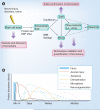Blood-based diagnostics of traumatic brain injuries
- PMID: 21171922
- PMCID: PMC3063529
- DOI: 10.1586/erm.10.104
Blood-based diagnostics of traumatic brain injuries
Abstract
Traumatic brain injury is a major health and socioeconomic problem that affects all societies. However, traditional approaches to the classification of clinical severity are the subject of debate and are being supplemented with structural and functional neuroimaging, as the need for biomarkers that reflect elements of the pathogenetic process is widely recognized. Basic science research and developments in the field of proteomics have greatly advanced our knowledge of the mechanisms involved in damage and have led to the discovery and rapid detection of new biomarkers that were not available previously. However, translating this research for patients' benefits remains a challenge. In this article, we summarize new developments, current knowledge and controversies, focusing on the potential role of these biomarkers as diagnostic, prognostic and monitoring tools of brain-injured patients.
Figures






Similar articles
-
Moderate and severe traumatic brain injury in adults.Lancet Neurol. 2008 Aug;7(8):728-41. doi: 10.1016/S1474-4422(08)70164-9. Lancet Neurol. 2008. PMID: 18635021 Review.
-
Exploring Serum Biomarkers for Mild Traumatic Brain Injury.In: Kobeissy FH, editor. Brain Neurotrauma: Molecular, Neuropsychological, and Rehabilitation Aspects. Boca Raton (FL): CRC Press/Taylor & Francis; 2015. Chapter 22. In: Kobeissy FH, editor. Brain Neurotrauma: Molecular, Neuropsychological, and Rehabilitation Aspects. Boca Raton (FL): CRC Press/Taylor & Francis; 2015. Chapter 22. PMID: 26269900 Free Books & Documents. Review.
-
Large-scale informatic analysis to algorithmically identify blood biomarkers of neurological damage.Proc Natl Acad Sci U S A. 2020 Aug 25;117(34):20764-20775. doi: 10.1073/pnas.2007719117. Epub 2020 Aug 6. Proc Natl Acad Sci U S A. 2020. PMID: 32764143 Free PMC article.
-
Detection of neurofilament-H in serum as a diagnostic tool to predict injury severity in patients who have suffered mild traumatic brain injury.J Neurosurg. 2014 Nov;121(5):1232-8. doi: 10.3171/2014.7.JNS132474. Epub 2014 Sep 5. J Neurosurg. 2014. PMID: 25192482
-
A review of magnetic resonance imaging and diffusion tensor imaging findings in mild traumatic brain injury.Brain Imaging Behav. 2012 Jun;6(2):137-92. doi: 10.1007/s11682-012-9156-5. Brain Imaging Behav. 2012. PMID: 22438191 Free PMC article. Review.
Cited by
-
Mild TBI Results in a Long-Term Decrease in Circulating Phospholipids in a Mouse Model of Injury.Neuromolecular Med. 2017 Mar;19(1):122-135. doi: 10.1007/s12017-016-8436-4. Epub 2016 Aug 19. Neuromolecular Med. 2017. PMID: 27540748
-
Human traumatic brain injury induces autoantibody response against glial fibrillary acidic protein and its breakdown products.PLoS One. 2014 Mar 25;9(3):e92698. doi: 10.1371/journal.pone.0092698. eCollection 2014. PLoS One. 2014. PMID: 24667434 Free PMC article. Clinical Trial.
-
Systems biology approaches for discovering biomarkers for traumatic brain injury.J Neurotrauma. 2013 Jul 1;30(13):1101-16. doi: 10.1089/neu.2012.2631. J Neurotrauma. 2013. PMID: 23510232 Free PMC article. Review.
-
Terahertz spectroscopic diagnosis of early blast-induced traumatic brain injury in rats.Biomed Opt Express. 2020 Jul 6;11(8):4085-4098. doi: 10.1364/BOE.395432. eCollection 2020 Aug 1. Biomed Opt Express. 2020. PMID: 32923030 Free PMC article.
-
Proteomic Analysis and Biochemical Correlates of Mitochondrial Dysfunction after Low-Intensity Primary Blast Exposure.J Neurotrauma. 2019 May 15;36(10):1591-1605. doi: 10.1089/neu.2018.6114. Epub 2019 Jan 14. J Neurotrauma. 2019. PMID: 30484371 Free PMC article.
References
-
- Ghajar J. Traumatic brain injury. Lancet. 2000;356:923–929. - PubMed
-
- Cole TB. Global road safety crisis remedy sought, 1.2 million killed, 50 million injured annually. JAMA. 2004;291:2531–2532. - PubMed
-
- Traumatic brain injury, time to end the silence. Lancet Neurol. 2010;9:331. - PubMed
-
- Brown AF, Cullen L, Than M. Future developments in chest pain diagnosis and management. Med. Clin. North Am. 2010;94:375–400. - PubMed
-
- Stocchetti N, Pagan F, Calappi E, et al. Inaccurate early assessment of neurological severity in head injury. J. Neurotrauma. 2004;21:1131–1140. - PubMed
Publication types
MeSH terms
Substances
Grants and funding
LinkOut - more resources
Full Text Sources
Other Literature Sources
